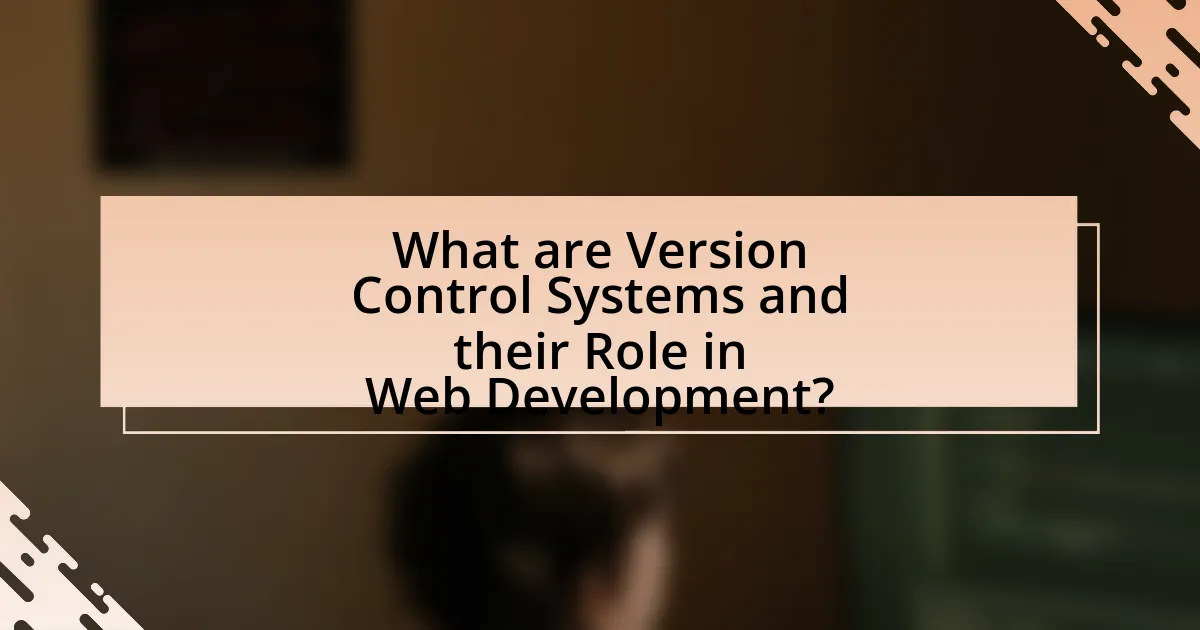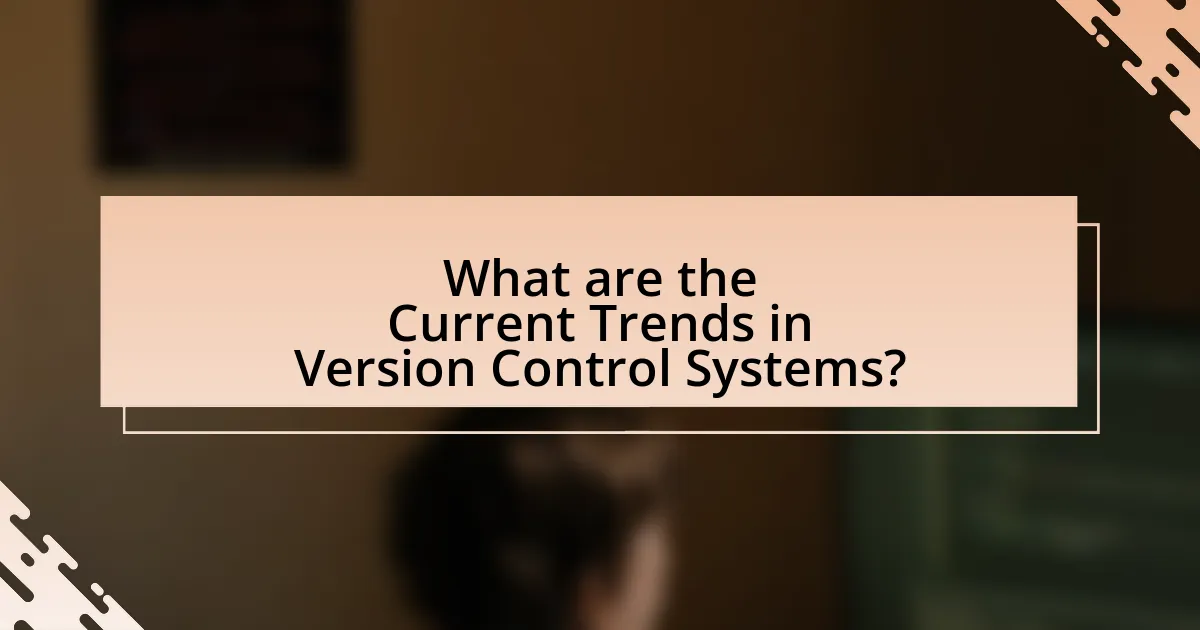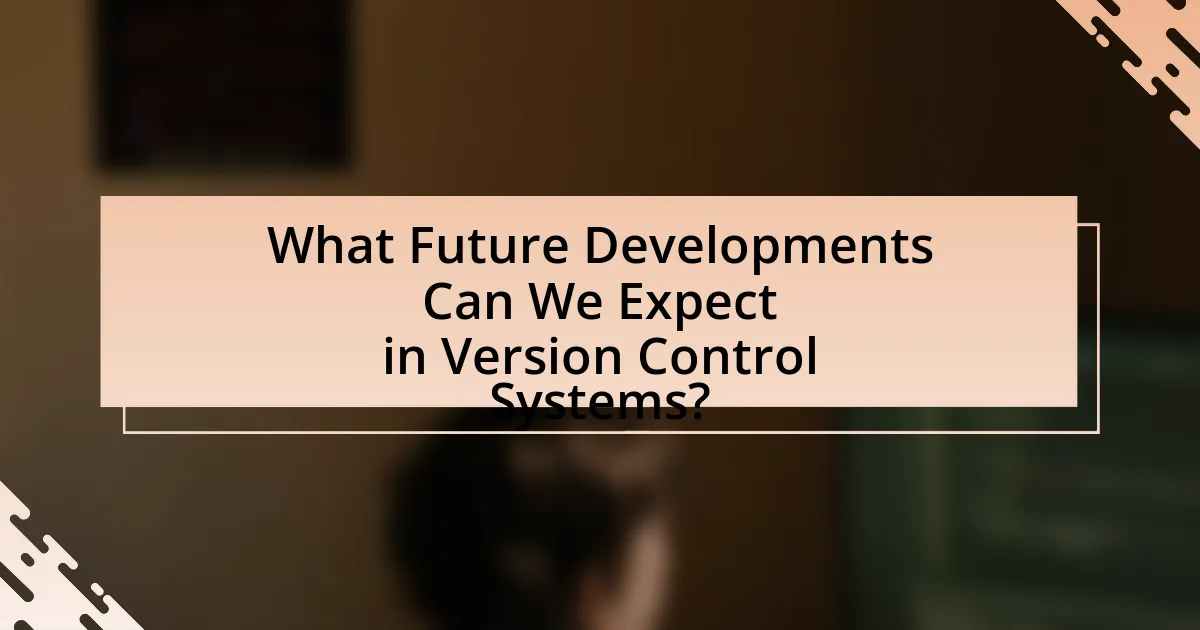Version Control Systems (VCS) are essential tools in web development that facilitate collaboration, track changes, and manage code efficiently. This article explores the critical role of VCS, particularly focusing on systems like Git, and discusses their functionality, key components, and the challenges developers face without them. It also examines current trends such as cloud integration, automation, and the influence of artificial intelligence and blockchain technology on VCS. Additionally, best practices for effective version control and common pitfalls to avoid are highlighted, providing a comprehensive overview of the future developments in version control systems within the web development landscape.
What are Version Control Systems and their Role in Web Development?

Version Control Systems (VCS) are tools that help developers manage changes to source code over time. In web development, VCS play a crucial role by enabling collaboration among multiple developers, tracking modifications, and facilitating the rollback of code to previous versions if necessary. For instance, Git, a widely used VCS, allows teams to work simultaneously on different features without overwriting each other’s work, thereby enhancing productivity and reducing errors. According to a survey by Stack Overflow, over 90% of developers use version control systems, highlighting their importance in modern software development practices.
How do Version Control Systems function in web development projects?
Version Control Systems (VCS) function in web development projects by managing changes to source code over time, allowing multiple developers to collaborate efficiently. VCS tracks modifications, enabling developers to revert to previous versions, compare changes, and resolve conflicts that arise when multiple contributors work on the same codebase. For instance, systems like Git facilitate branching, where developers can create separate lines of development, test features, and merge changes back into the main project seamlessly. This functionality is crucial for maintaining code integrity and ensuring that development teams can work concurrently without overwriting each other’s contributions.
What are the key components of Version Control Systems?
The key components of Version Control Systems (VCS) include repositories, commits, branches, and merges. Repositories serve as the storage location for all versions of files, allowing users to track changes over time. Commits represent individual changes made to the files, capturing the state of the project at specific points. Branches enable parallel development by allowing users to work on different features or fixes without affecting the main codebase. Merges combine changes from different branches, integrating the work done by multiple contributors. These components collectively facilitate collaboration, maintain project history, and enhance code management in software development.
How do Version Control Systems manage changes in code?
Version Control Systems (VCS) manage changes in code by tracking modifications to files over time, allowing multiple users to collaborate efficiently. They achieve this through a system of commits, where each change is recorded with a unique identifier, timestamp, and author information. This enables users to revert to previous versions, compare changes, and merge contributions from different developers seamlessly. For instance, Git, a widely used VCS, employs a distributed model that allows each user to maintain a complete history of changes locally, facilitating offline work and reducing dependency on a central server. This structured approach to change management enhances collaboration, minimizes conflicts, and ensures code integrity throughout the development process.
Why are Version Control Systems essential for collaboration in web development?
Version Control Systems (VCS) are essential for collaboration in web development because they enable multiple developers to work on the same project simultaneously without conflicts. VCS tracks changes made to code, allowing team members to merge their contributions seamlessly, revert to previous versions if necessary, and maintain a comprehensive history of modifications. This functionality is crucial in environments where teams are distributed or working on complex projects, as it minimizes the risk of overwriting each other’s work and enhances overall productivity. According to a survey by GitHub, 87% of developers reported that using a VCS improved their collaboration efforts, highlighting its importance in modern web development practices.
How do Version Control Systems facilitate teamwork among developers?
Version Control Systems (VCS) facilitate teamwork among developers by enabling collaborative code management, allowing multiple developers to work on the same project simultaneously without conflicts. VCS provides features such as branching and merging, which allow developers to create separate lines of development for new features or bug fixes, and later integrate their changes back into the main codebase. This process minimizes the risk of overwriting each other’s work and ensures that all contributions are tracked and can be reviewed. Additionally, VCS maintains a history of changes, which aids in accountability and makes it easier to identify when and why changes were made, fostering better communication and coordination among team members.
What challenges do developers face without Version Control Systems?
Developers face significant challenges without Version Control Systems, including difficulty in tracking changes, increased risk of data loss, and collaboration issues. Without a system to manage code revisions, developers struggle to identify who made specific changes and when, leading to confusion and potential errors. The absence of version control also heightens the risk of losing work due to accidental deletions or overwrites, as there is no backup mechanism to restore previous versions. Furthermore, collaboration becomes cumbersome, as multiple developers working on the same project may overwrite each other’s changes, resulting in conflicts and inefficiencies. These challenges underscore the critical role of Version Control Systems in modern software development.
What are the Current Trends in Version Control Systems?

Current trends in version control systems include increased adoption of cloud-based solutions, enhanced collaboration features, and integration with continuous integration/continuous deployment (CI/CD) pipelines. Cloud-based version control systems, such as GitHub and GitLab, allow for easier access and collaboration among distributed teams, facilitating real-time updates and feedback. Enhanced collaboration features, like pull requests and code reviews, streamline the development process and improve code quality. Furthermore, the integration of version control systems with CI/CD pipelines automates testing and deployment, leading to faster release cycles and more reliable software delivery. These trends reflect the growing need for efficiency and collaboration in modern software development environments.
How is cloud integration shaping the future of Version Control Systems?
Cloud integration is significantly shaping the future of Version Control Systems (VCS) by enhancing collaboration, accessibility, and scalability. With cloud-based VCS, developers can access repositories from anywhere, facilitating real-time collaboration across distributed teams. This shift is evidenced by the increasing adoption of platforms like GitHub and GitLab, which reported millions of active users and repositories, indicating a trend towards cloud-centric development workflows. Furthermore, cloud integration allows for automated backups and versioning, reducing the risk of data loss and improving project management efficiency. As organizations increasingly prioritize remote work and agile methodologies, the reliance on cloud-integrated VCS will continue to grow, making it a cornerstone of modern software development practices.
What advantages does cloud-based Version Control offer?
Cloud-based Version Control offers enhanced collaboration, accessibility, and scalability. Teams can work simultaneously on projects from different locations, facilitating real-time updates and reducing conflicts. Additionally, cloud-based systems provide automatic backups and version history, ensuring data integrity and easy recovery. According to a survey by GitHub, 83% of developers reported improved collaboration when using cloud-based tools, highlighting their effectiveness in modern web development environments.
How are security concerns addressed in cloud-based systems?
Security concerns in cloud-based systems are addressed through a combination of encryption, access controls, and compliance with regulatory standards. Encryption protects data both at rest and in transit, ensuring that unauthorized users cannot access sensitive information. Access controls, including multi-factor authentication and role-based permissions, limit user access to only necessary data and functions, reducing the risk of breaches. Additionally, cloud providers often comply with industry standards such as ISO 27001 and GDPR, which mandate specific security practices and audits, thereby enhancing overall security posture. These measures collectively mitigate risks associated with data breaches and unauthorized access in cloud environments.
What role does automation play in the evolution of Version Control Systems?
Automation significantly enhances the efficiency and reliability of Version Control Systems (VCS) by streamlining repetitive tasks and reducing human error. This evolution is evident in features such as automated merging, conflict resolution, and continuous integration, which allow developers to focus on coding rather than manual processes. For instance, tools like GitHub Actions and GitLab CI/CD automate testing and deployment, ensuring that code changes are validated and integrated seamlessly. The integration of automation in VCS has led to faster development cycles and improved collaboration among teams, as evidenced by the widespread adoption of these tools in modern software development practices.
How can automation improve workflow efficiency in web development?
Automation can significantly improve workflow efficiency in web development by streamlining repetitive tasks and reducing human error. By implementing tools such as continuous integration and deployment (CI/CD), developers can automate testing, building, and deploying applications, which accelerates the development cycle. For instance, a study by GitLab found that organizations using CI/CD practices can deploy code 200 times more frequently than those that do not, leading to faster feedback loops and quicker iterations. This efficiency not only enhances productivity but also allows developers to focus on more complex tasks, ultimately improving the overall quality of the software produced.
What tools are available for automating Version Control processes?
Tools available for automating Version Control processes include GitHub Actions, GitLab CI/CD, Jenkins, and Bitbucket Pipelines. These tools facilitate continuous integration and deployment, allowing developers to automate workflows related to version control. For instance, GitHub Actions enables users to create workflows that automatically build, test, and deploy code based on repository events, enhancing efficiency and reducing manual errors. Similarly, GitLab CI/CD integrates directly with GitLab repositories to automate testing and deployment processes, streamlining development cycles. Jenkins, a widely used automation server, supports building, deploying, and automating projects, while Bitbucket Pipelines offers a seamless integration for continuous delivery directly within Bitbucket repositories.
What Future Developments Can We Expect in Version Control Systems?

Future developments in version control systems are expected to focus on enhanced automation, improved collaboration features, and integration with artificial intelligence. Automation will streamline workflows, allowing for automatic merging and conflict resolution, which can significantly reduce manual intervention. Improved collaboration features will facilitate real-time editing and better communication among team members, making it easier to manage contributions from multiple developers. Integration with artificial intelligence will enable predictive analytics for code quality and suggest improvements, thereby enhancing overall development efficiency. These trends are supported by the increasing adoption of DevOps practices, which emphasize continuous integration and delivery, as well as the growing complexity of software projects that necessitate more sophisticated version control solutions.
How will artificial intelligence influence Version Control Systems?
Artificial intelligence will significantly enhance Version Control Systems by automating code reviews and improving collaboration among developers. AI algorithms can analyze code changes, identify potential issues, and suggest improvements, thereby reducing the time spent on manual reviews. For instance, tools like GitHub Copilot utilize machine learning to assist developers in writing code, which streamlines the development process. Additionally, AI can facilitate better conflict resolution by predicting merge conflicts and offering solutions based on historical data, ultimately leading to more efficient workflows.
What potential applications of AI can enhance Version Control functionalities?
AI can enhance Version Control functionalities through automated code review, intelligent conflict resolution, and predictive analytics for project management. Automated code review utilizes machine learning algorithms to analyze code changes, ensuring adherence to coding standards and identifying potential bugs before integration. Intelligent conflict resolution employs AI to analyze changes made by multiple contributors, suggesting optimal resolutions based on historical data and patterns. Predictive analytics can forecast project timelines and resource needs by analyzing past version control data, enabling better planning and efficiency. These applications demonstrate how AI can significantly improve the effectiveness and reliability of version control systems in web development.
How might AI change the way developers interact with Version Control Systems?
AI will significantly enhance how developers interact with Version Control Systems (VCS) by automating routine tasks and providing intelligent insights. For instance, AI can streamline code reviews by automatically suggesting improvements and identifying potential bugs, which reduces the time developers spend on manual checks. Additionally, AI-driven tools can analyze commit history to predict potential merge conflicts, allowing developers to address issues proactively. Research indicates that integrating AI into VCS can lead to a 30% increase in productivity by minimizing repetitive tasks and enhancing collaboration among team members.
What emerging technologies are likely to impact Version Control Systems?
Emerging technologies likely to impact Version Control Systems include artificial intelligence, blockchain, and cloud computing. Artificial intelligence can enhance code review processes and automate conflict resolution, improving collaboration and efficiency. Blockchain technology offers secure, decentralized version tracking, ensuring data integrity and transparency in collaborative environments. Cloud computing facilitates real-time collaboration and access to version control systems from anywhere, streamlining workflows and enhancing team productivity. These technologies are reshaping how developers manage code, making version control more efficient and secure.
How can blockchain technology be integrated into Version Control Systems?
Blockchain technology can be integrated into Version Control Systems (VCS) by utilizing its decentralized ledger capabilities to enhance security, transparency, and traceability of code changes. This integration allows for immutable records of all modifications made to the codebase, ensuring that every change is verifiable and cannot be altered retroactively. For instance, using blockchain, each commit can be recorded as a transaction, providing a clear history of contributions and accountability among developers. This approach not only mitigates risks of unauthorized changes but also facilitates collaboration by allowing multiple stakeholders to access a single source of truth regarding the project’s evolution.
What benefits could decentralized Version Control Systems provide?
Decentralized Version Control Systems (DVCS) provide enhanced collaboration, improved data integrity, and increased flexibility. These systems allow multiple users to work on a project simultaneously without the need for a central server, which fosters real-time collaboration and reduces bottlenecks. Additionally, DVCS ensures that every user has a complete copy of the project history, enhancing data integrity by allowing users to revert to previous versions easily. The flexibility of DVCS also enables developers to work offline and synchronize changes later, accommodating various workflows and environments. These benefits contribute to more efficient development processes and greater resilience against data loss.
What best practices should developers follow for effective Version Control?
Developers should follow several best practices for effective version control, including using meaningful commit messages, maintaining a clean commit history, and regularly merging changes. Meaningful commit messages enhance clarity and understanding of changes made, while a clean commit history facilitates easier navigation and debugging. Regularly merging changes helps prevent conflicts and ensures that the codebase remains up-to-date, which is crucial in collaborative environments. These practices are supported by industry standards, such as the Git documentation, which emphasizes the importance of clear communication and organization in version control workflows.
How can developers ensure proper branching and merging strategies?
Developers can ensure proper branching and merging strategies by adopting a clear branching model, such as Git Flow or GitHub Flow, which defines how branches are created and merged. Implementing a consistent naming convention for branches helps in identifying the purpose of each branch, facilitating easier collaboration among team members. Additionally, utilizing pull requests for code reviews before merging changes into the main branch enhances code quality and reduces integration issues. Automated testing and continuous integration practices further validate that merged code does not introduce errors, ensuring stability in the codebase. These strategies are supported by industry best practices, as evidenced by the widespread adoption of Git Flow in professional software development environments, which has been shown to improve team productivity and code quality.
What are the common pitfalls to avoid when using Version Control Systems?
Common pitfalls to avoid when using Version Control Systems include neglecting to commit frequently, which can lead to lost work and complicated merges. Additionally, failing to write clear commit messages can hinder collaboration and understanding of project history. Another pitfall is not utilizing branches effectively, resulting in a cluttered main branch and increased risk of conflicts. Ignoring the importance of regular backups can also lead to data loss. Lastly, not keeping the version control system updated can expose users to security vulnerabilities and bugs. These pitfalls can significantly impact project efficiency and team collaboration.